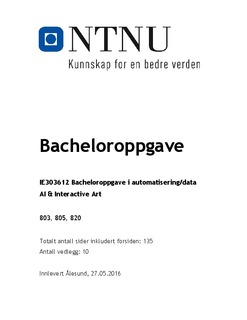| dc.contributor.advisor | Karlsen, Anniken | |
| dc.contributor.advisor | Styve, Arne | |
| dc.contributor.advisor | Bye, Robin | |
| dc.contributor.author | Eik, Terje | |
| dc.contributor.author | Sæter, Stein-Are | |
| dc.contributor.author | Espenakk, Erik | |
| dc.date.accessioned | 2016-10-14T07:24:50Z | |
| dc.date.available | 2016-10-14T07:24:50Z | |
| dc.date.issued | 2016 | |
| dc.identifier.uri | http://hdl.handle.net/11250/2415139 | |
| dc.description.abstract | Interactive art is an art form that emerges between the installation and the audience. With the advent of computer-based interactivity in the 1990s, interactive art has become increasingly popular, with programmable machines enabling the creation of unique artwork for each audience. In academic communities within NTNU, interactive art has been incorporated as a problem domain in software development and programming classes to encourage and motivate students and act as a driver for learning. | nb_NO |
| dc.description.abstract | The artistic idea behind the project is about the production of social subjectivity and human collectivities within contemporary society. Normally we humans think that we are individuals with free will that can move, think and talk as we want to, but then we notice that there are social strains, and that our movements and whereabouts are strongly affected by others like friends, family and governmental bodies. We are continuously being measured, registered and controlled. Social media, television and electronic networks are all influential to how we interact in different arenas, and may also exert pressure or force upon us to take part in things we might not want. | nb_NO |
| dc.description.abstract | To investigate this an environment has been created in Unity 3D for Oculus Rift. The user is sent through an interactive roller coaster with stations where certain tasks has to be fulfilled before the user can move on, focusing on social subjectivity. Microsoft Kinect is used to implement interaction, detecting the hand gestures and movements to lift up object and move them. | nb_NO |
| dc.description.abstract | This thesis focuses on the planning and development of the installation, and goes through relevant theory in addition to the methodologies and technologies used. The result of the project is also discussed, comparing the installation to other similar installations found on the Internet. | nb_NO |
| dc.language.iso | eng | nb_NO |
| dc.rights | Navngivelse-Ikkekommersiell-IngenBearbeidelse 3.0 Norge | * |
| dc.rights.uri | http://creativecommons.org/licenses/by-nc-nd/3.0/no/ | * |
| dc.subject | Interactive art | nb_NO |
| dc.subject | Microsoft Kinect | nb_NO |
| dc.title | AI & Interactive Art | nb_NO |
| dc.type | Bachelor thesis | nb_NO |
| dc.subject.nsi | VDP::Technology: 500::Information and communication technology: 550::Computer technology: 551 | nb_NO |
| dc.source.pagenumber | 135 | nb_NO |

